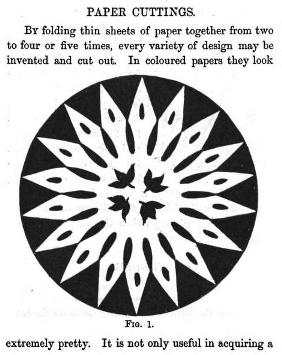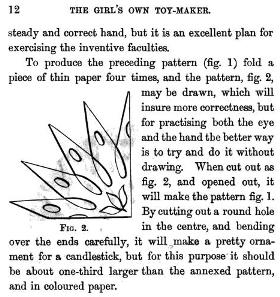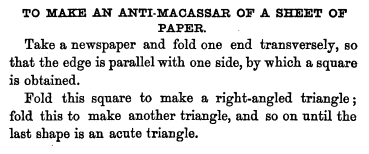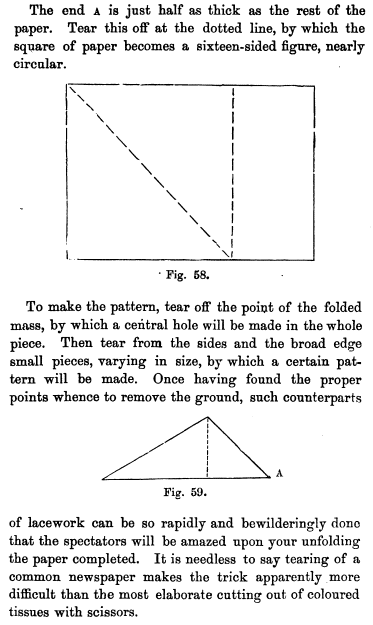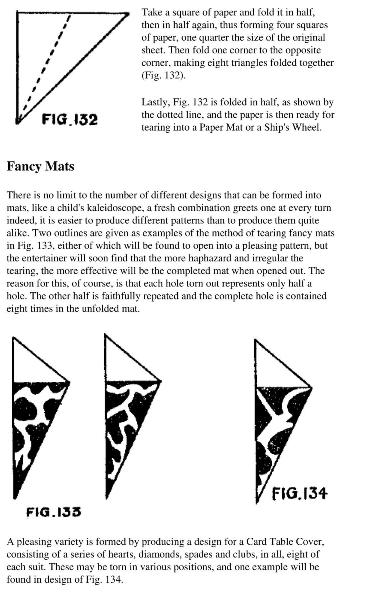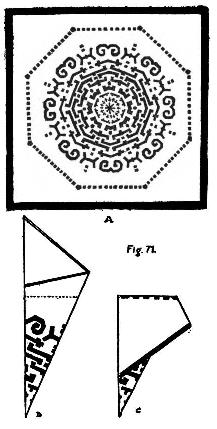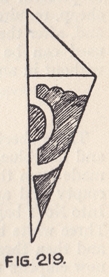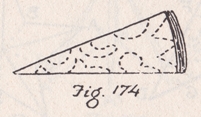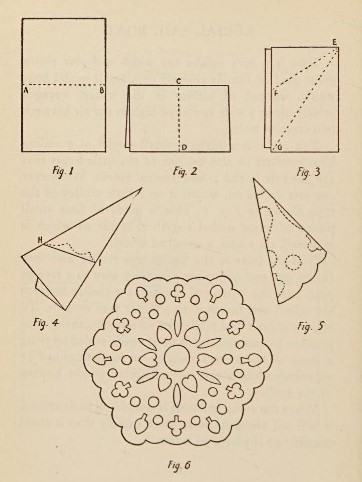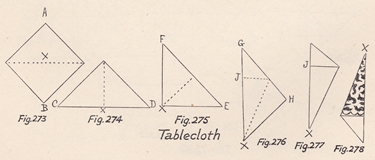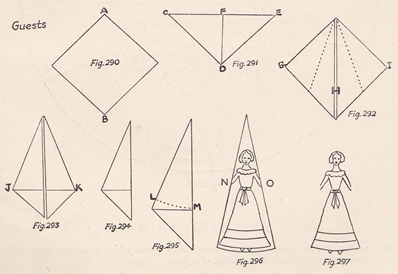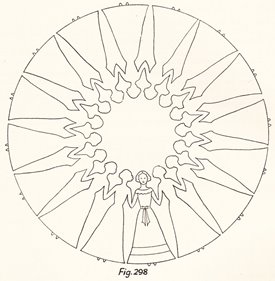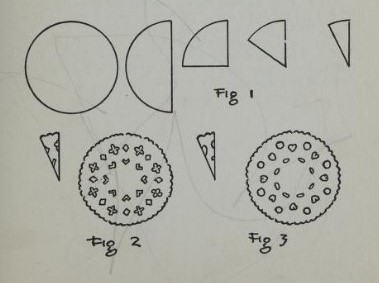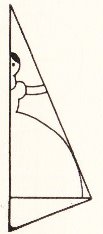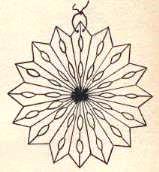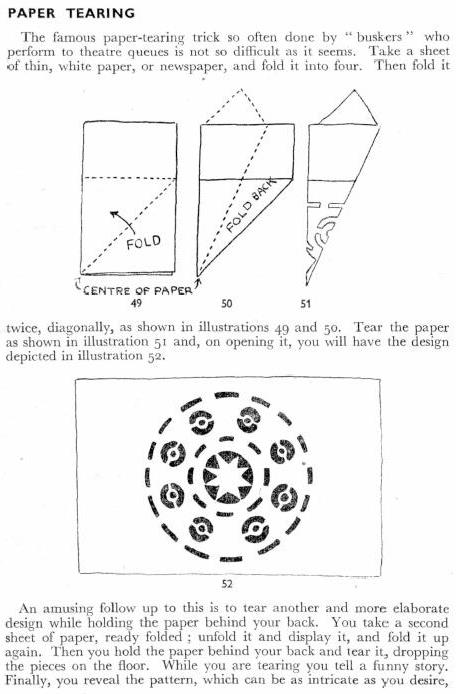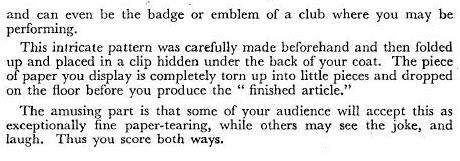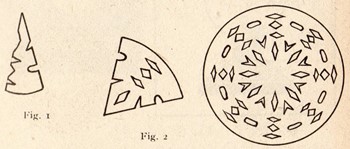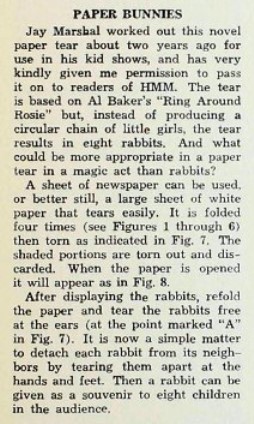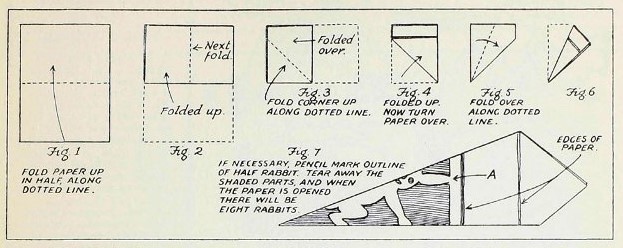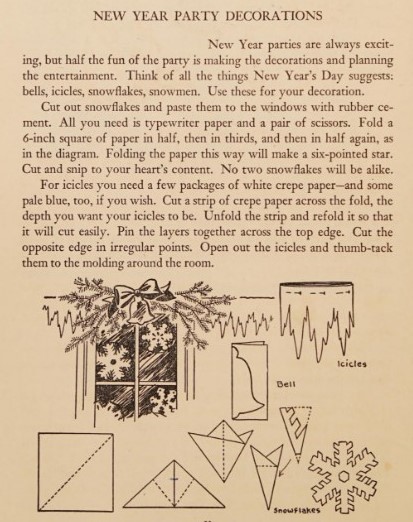| The Public Paperfolding History Project
Last updated 20/7/2025 x |
|||||||
| Fold and Cut Paper Doilies | |||||||
| This
page is being used to collect information about the
history of Paper Doilies, which I define as perforated
designs cut or torn from squares that possess eightfold
rotational symmetry. Paper Doilies and are still widely
made as a craft activity in British primary schools. The cutting of patterns in complex symmetric patterns of this kind has sometimes been included in conjuring performances. There is a separate page about the history of the specific Paper Doily design and magical effect known as The Ship's Wheel. There is a separate page about Paper Snowflakes (ie a similar class of design, but possessing only sixfold symmetry). ********** 1860 As far as I know the earliest known instruction for making a Paper Doily appear under the title 'Paper Cuttings' in 'The Girl's Own Toymaker' by Ebenezer Landells and Alice Landells was published in 1860 by Griffin and Farran in London and Shephard, Clark and Brown in Boston.
********** 1872 Brief instructions for a making patterns with sixteen-fold symmetry appear in 'Hanky Panky', a book of magical effects, puzzles, recreational mathematics and other amusements, by W H Cremer, Jun, which was published by John Camden Hotten in London in 1872. No specific pattern is suggested.
********** The effect also appears: 1920 Under the title 'Fancy Mats' in 'Paper Magic' by Will Blyth, which was first published by C Arthur Pearson in London in 1920. The same book includes similar instructions for malking the Ship's Wheel.
********** 1922 In 'Houdini's Paper Magic', which was published by E P Dutton and Company of New York in 1922, includes instructions for several complex versions of the Paper Doily intended to be performed as magical effects. One of these is stated to be of Japanese origin.
********** 1923 As 'The Brownies' Tea Cloth' in 'More Paper Magic' by Will Blyth, which was published by C Arthur Pearson in London in 1923.
********** 1928 In 'Fun with Paperfolding' by William D Murray and Francis J Rigney was published by the Fleming H Revell Company, New York in 1928.
********** 1932 In 'La Nature' Issue 2872 of 1st January 1932 in an article by Alber headed 'Dechirures et Dechiquetures de Papier' (Paper Tearing and Shredding?).
********** As 'A Fancy Tea Cloth' in 'Winter Nights Entertainments' by R M Abraham, which was first published by Constable and Constable in London in 1932.
********** 1935 'La Nature' Issue 2944 of 1st January 1935 contained an article by Alber which explained how to present the making of several versions of the Chain of Dolls and Paper Doilies as magical effects.
********** 1936 Under the title of 'Paper Cutting' in 'More Things Any Boy Can Make' by Joseph Leeming, which was published by D Appleton-Century Company in New York and London in 1936.
********** 1937 As 'The Table-Cloth' in 'Paper Toy Making' by Margaret Campbell was first published by Sir Isaac Pitman and Sons Ltd in London, probably in 1937, although both the Foreword and Preface are dated 1936, which argues that the book was complete at that date.
*** A similar method is used in the same book to create 'Guests', which is a cross between a Paper Doily and a Chain of Dolls.
********** 1939 As 'Decorative Paper Mats or Doilies' in 'Fun with Paper' by Joseph Leeming, which was published by Spencer Press Inc in Chicago in 1939.
********** 1940 In 'At Home Tonight' by Herbert McKay, which was published by Oxford University Press in London, New York and Toronto in 1940, contains the standard Paper Doily effect, under the title of 'Paper Mats', as well as an effect called 'Dancers', which is similar to 'Guests' in Margaret Campbell's 'Paper Toy Making' except that in this case the circle of figures is intended to stand upright rather than lay flat.
********** In 'El Plegado y Cartonaje en la Escuela Primaria' by Antonio M Luchia and Corina Luciani de Luchia, which was published by Editorial Kapelusz in Buenos Aires in 1940, and which contains a section about 'Figuras Simetricos Recortadas'.
********** 1947 In 'Willane's Wizardry' by Willane, which was pubished by ARCAS, in London, and has a foreword dated 1947, which contains the interesting information that this effect was often used by buskers performing to theatre queues.
********** 1949 In 'Au Pays des Mains Agiles', which was published by Editions Fleurus in Paris in 1949, as 'Des Napperons'.
********** A version of the effect that would produce a ring of eight rabbits, worked out by Jay Marshall, and intended for use entertaining children, was explained in an article by Martin Gardner, titled 'Stunts with Paper' published in 'Hugard's Magic Monthly' for September 1949.
********** 1950 A design for six-fold symmetry 'Snowflakes' appears in 'Holiday Craft and Fun' by Joseph Leeming, which was published by J B Lipincott Company in Philadelphia and New York in 1950.
********** 1963 'Fell's Guide to Papercraft: Tricks, Games and Puzzles' by Walter B Gibson, which was published by Frederick Fell Inc in New York and George McLeod Ltd in Toronto in 1963, contains several patterns for Paper Doilies, the first of which is titled 'The Snowflake' even though it has eightfold symmetry, and others for Ship's Wheels.
********** |
|||||||
